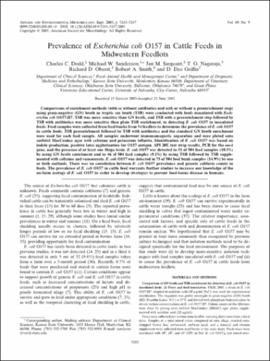| dc.contributor.author | Dodd, Charles C. | |
| dc.contributor.author | Sanderson, Michael W. | |
| dc.contributor.author | Sargeant, Jan M. | |
| dc.contributor.author | Nagaraja, T. G. | |
| dc.contributor.author | Oberst, Richard D. | |
| dc.contributor.author | Smith, Robert A. | |
| dc.contributor.author | Griffin, D. Dee | |
| dc.date.accessioned | 2018-08-29T14:24:26Z | |
| dc.date.available | 2018-08-29T14:24:26Z | |
| dc.date.issued | 2003-09 | |
| dc.identifier | oksd_dodd_prevalenceofesc_2003 | |
| dc.identifier.citation | Dodd, C. C., Sanderson, M. W., Sargeant, J. M., Nagaraja, T. G., Oberst, R. D., Smith, R. A., & Griffin, D. D. (2003). Prevalence of Escherichia coli O157 in cattle feeds in Midwestern feedlots. Applied and Environmental Microbiology, 69(9), 5243-5247. https://doi.org/10.1128/AEM.69.9.5243-5247.2003 | |
| dc.identifier.uri | https://hdl.handle.net/11244/301595 | |
| dc.description.abstract | Comparisons of enrichment methods (with or without antibiotics and with or without a preenrichment step) using gram-negative (GN) broth or tryptic soy broth (TSB) were conducted with feeds inoculated with Escherichia coli O157:H7. TSB was more sensitive than GN broth, and TSB with a preenrichment step followed by TSB with antibiotics was more sensitive than plain TSB enrichment, in detecting E. coli O157 in inoculated feeds. Feed samples were collected from feed bunks from 54 feedlots to determine the prevalence of E. coli O157 in cattle feeds. TSB preenrichment followed by TSB with antibiotics and the standard GN broth enrichment were used for each feed sample. All samples underwent immunomagnetic separation and were plated onto sorbitol MacConkey agar with cefixime and potassium tellurite. Identification of E. coli O157 was based on indole production, positive latex agglutination for O157 antigen, API 20E test strip results, PCR for the eaeA gene, and the presence of at least one Shiga toxin. E. coli O157 was detected in 52 of 504 feed samples (10.3%) by using GN broth enrichment and in 46 of 504 feed samples (9.1%) by using TSB followed by TSB supplemented with cefixime and vancomycin. E. coli O157 was detected in 75 of 504 feed bunk samples (14.9%) by one or both methods. There was no correlation between E. coli O157 prevalence and generic coliform counts in feeds. The prevalence of E. coli O157 in cattle feed warrants further studies to increase our knowledge of the on-farm ecology of E. coli O157 in order to develop strategies to prevent food-borne disease in humans. | |
| dc.format | application/pdf | |
| dc.language | en_US | |
| dc.publisher | American Society for Microbiology | |
| dc.rights | This material has been previously published. In the Oklahoma State University Library's institutional repository this version is made available through the open access principles and the terms of agreement/consent between the author(s) and the publisher. The permission policy on the use, reproduction or distribution of the material falls under fair use for educational, scholarship, and research purposes. Contact Digital Resources and Discovery Services at lib-dls@okstate.edu or 405-744-9161 for further information. | |
| dc.title | Prevalence of Escherichia coli O157 in cattle feeds in Midwestern feedlots | |
| osu.filename | oksd_dodd_prevalenceofesc_2003.pdf | |
| dc.description.peerreview | Peer reviewed | |
| dc.identifier.doi | 10.1128/AEM.69.9.5243-5247.2003 | |
| dc.description.department | Veterinary Clinical Sciences | |
| dc.type.genre | Article | |
| dc.type.material | Text | |
| dc.subject.keywords | livestock | |
| dc.subject.keywords | bacteria | |
| dc.subject.keywords | enterobacteriaceae | |
